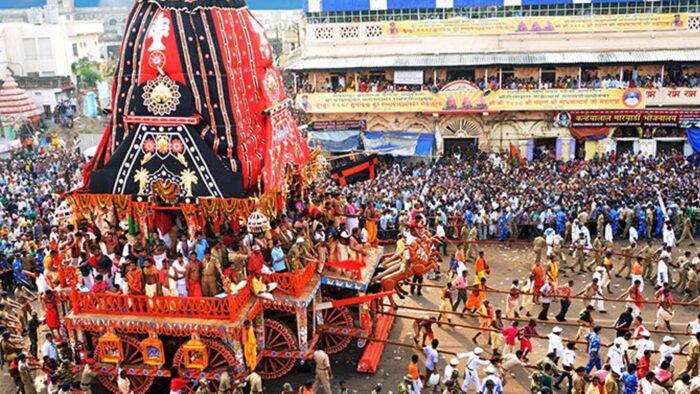On the auspicious day of Paguni Uttiram in the last week of March, the Lord of the worlds is taken out in a procession with his consort across temples in South India. The purappadu for the divine couple by the devotees goes on for hours, sometimes the whole night. Across India from Thiruvarur to Tirupati to Puri, this magnificent display of bhakti as people shoulder the Lord has been captured in a new book.
In his book Devaratham, a Study of the Temple Cars of India (published by IGNCA), Dr Susil Pani has put together his labour of love on the chariots of India. It is said that these chariots were made in Dwapara Yuga for the first time and the ratha uthsava observed. “In the period before that the uthsava murtis were seated directly on their vahanas and carried by men. With passage of time the rathams came into the forefront for major uthsavas like Brahma Utsava when the uthsava murthi was placed on the ratham with elaborate decorations and pulled along across the village and the temple,” writes Stapati Sri K Rajamani in the book.
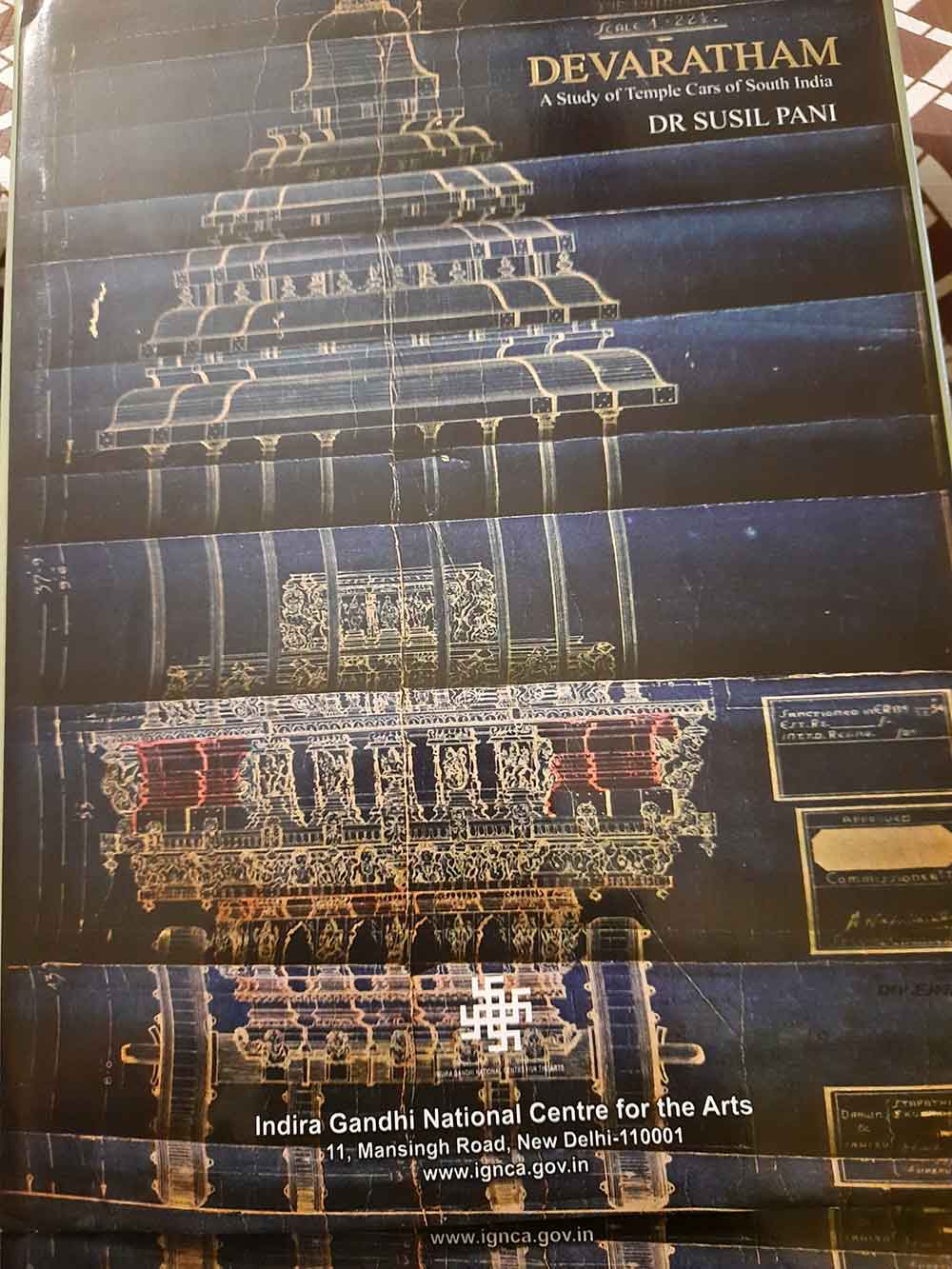
India has the largest and oldest temple chariot (Devaratham) processions in the world. Dr Pani quotes the introductory verse of the description of the devaratham in the Vishnutatva Samhita:
Ratham devamayam virpa sarvademayamm thatha
Sarvayajnamayam…
(The ratham is the embodiment of the god, an embodiment of all gods,
An embodiment of all sacrifices)
Rathas are mentioned in the Vedas, our Rishis considered themselves to be chariots and their verses their chariots. In an interview with CSP, he says rathas were important during this period. “A great detail description is there in the Vedas, particularly in the Rigveda describing the parts of the ratham. Ratham and vahana are used sometimes interchangeably. The deities identity is established by its vahana (ratham) used. Example is the bull or Nandi is for Shiva. But remember that the vahana had no identity of its own, but was a portion of the deity, in other words it drew its powers from the deity, hence Nandi is also known as Nandikeswara, the one who draws his powers from Eswara or Shiva. The symbolism of the ratham is aptly described in the Kathaupnishad comparing the human life on earth. The body is the physical ratham, the mind is the chariots sarathi, the soul is the rider or deity seated at the center, the whip the vital being and the final destination is the union with the Divine. Rishis did extreme tapasya to acquire rathams from the deities whom they worshiped or the powers associated with the deity, hence they could carry themselves to different worlds.”
Dr Sachchidanand Joshi, IGNCA, writes in the preface of the book that the Rig Veda uses the term ratham more than a thousand times, “along with a complete description of the components of the ratham like rathamokha (face of the ratham), charam (wheels), etc. The Sulabha sutras describe the methods and measurements in the art of making the devaratham. In the Puranas we have detailed descriptions of the rites and rituals for the consecration of the ratham known as Ratha prathistha vidhi. The epics Ramayana and Mahabharata have descriptions of the rathas. The most popular being Sri Krishna giving the knowledge of the Gita or Gitaaupadesa to his Sakha Arjuna.”
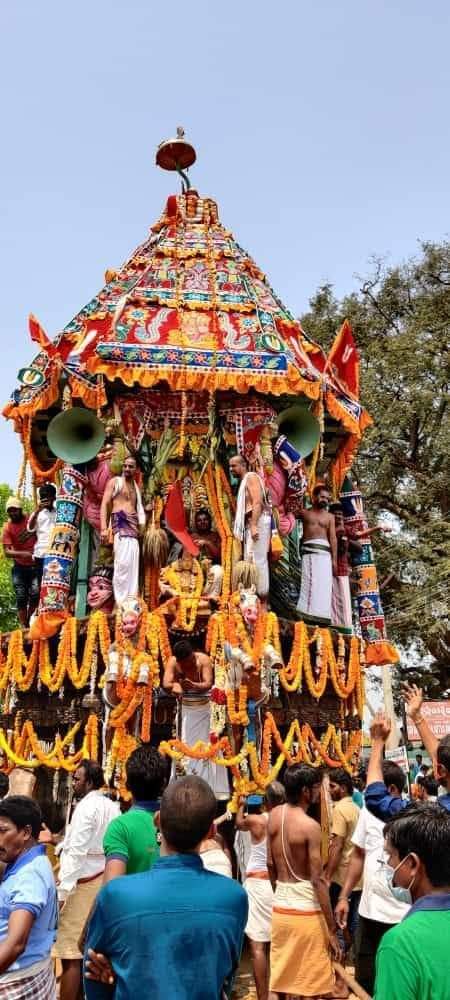
There are terracotta seals found in the Indus Valley depicting carts and almost every temple of antiquity today has rathams. The Konark temple is a giant chariot to the mighty Surya. The Vithala temple in Hampi is testament to the generosity of Krishna Devaraya towards temple activity. The largest and most spectacular cart festival today of Lord Jagannath of Puri, Orissa.
Dr Pani writes that the devarathams were replicas of the Devalaya or the temple and so there is a striking resemblance between them. “The height of the temple is in a fixed multiple of the height of the Moolavar or main deity. The same principle is used for the ratham; the height of the ratham is in a fixed multiple of the height of the uthsava murti. The height of the uthsava murti is also in a fixed ratio or proportion of that of the main deity. Similar to the temple, the ratham has an Upapitha, Adhisthana, Pada, Vimana, Sikhara and the stupa.”
Dr Pani points to the amazing scientific perceptiveness of our forefathers. He says the stability of the ratham (which weighs tons) is to be “attributed to the principle of unity, balance, distribution of weight, and proportional system as described in the scriptures. It provides both static and dynamic stability. All the elements of the ratham are interlinked to hold in position the ratham while stationary or while moving during the rathayatra and ratha uthsava. In addition to rings and nails, square shaped iron rods are placed strategically passing through from the platform to the base of the ratham to prevent the components of the ratham from disengaging during movement. The panels have holes or slots cut into each section which fits into the next section. There is just enough space between the panels and other parts to allow minimum movement and expansion due to exposure to moisture and sunlight.”
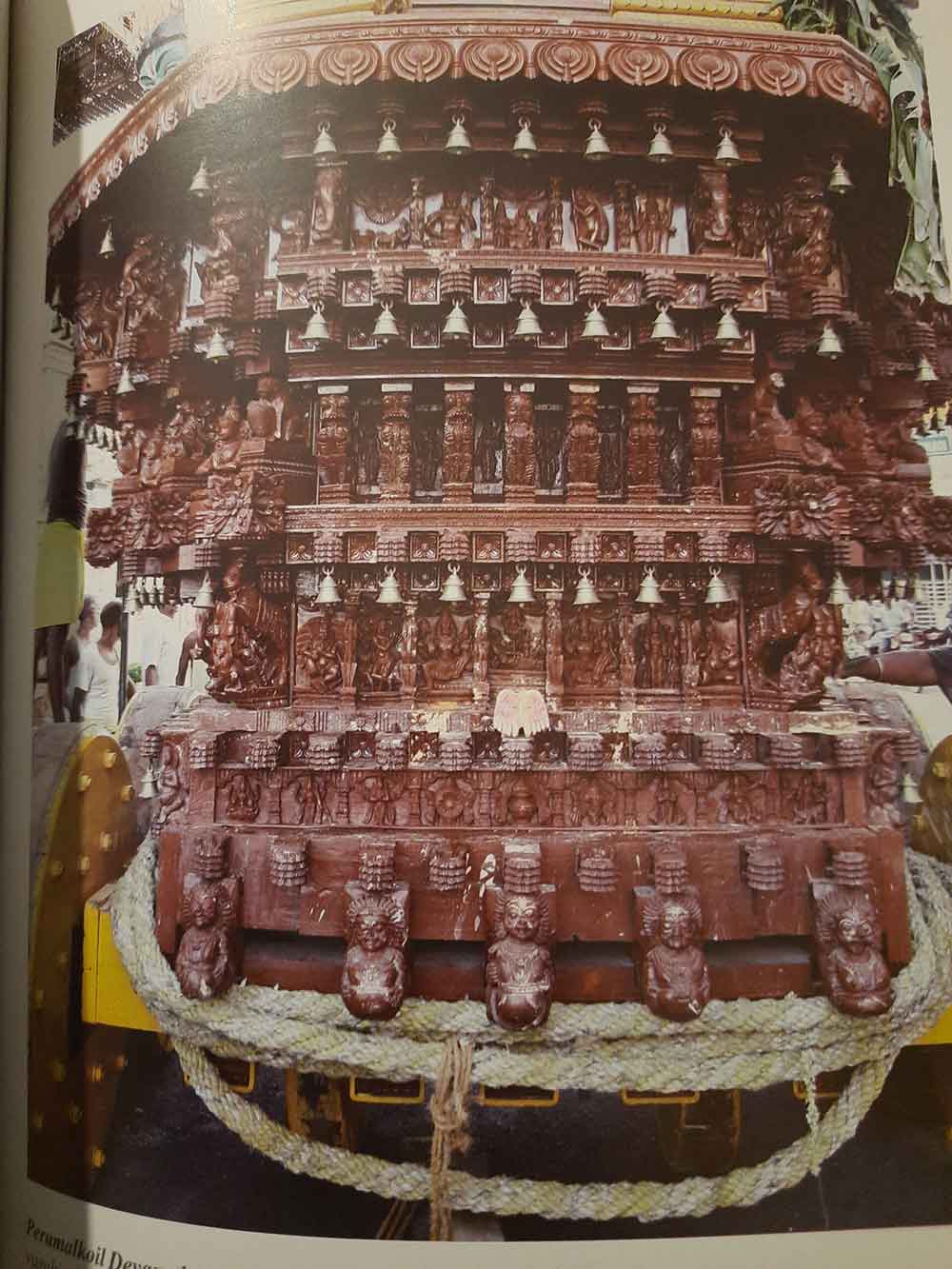
(Pic by Dr Susil Pani)
Wood was the preferred material by the sthapati to make the vahanas. “Due to the high cost of teak wood, other woods were used ike Mavilingam, Karrungal, Red Sandal, Nuna maram, Pala maram, Asthi maram, Manjanathai maram and Ellupimaram.” Dr Pani adds that a few temples have chariots made of gold and silver, including the Manakula Vinayaga temple in Puducherry. The Vitthala temple has a stone immovable ratham.
The author provides great detail on the movement of the rathams when it is taken out it procession. The teirtheru or car-street is usually as square around the temple, so that a complet parikrama is made of the temple. The four streets symbolise the four Vedas. “The devaratham is usually place opposite the east gate or gopuram facing south and the place is called as “Theiradi”.
Travelling from Madurai to Puducherry on work (he is an ophthalmologist), Dr Pani would see the ratham at Villianur in the outskirts of Puducherry. In 1996 he began taking pictures and documented all the three rathams of the temple in detail.
He researched the shastras to find out the minutest of details. “There is a separate manuscript for the ratham called as Viswakarmiya Ratha Laxanam, originally to have been written by Vishwakarma, the original is available in the Saraswati Mahal library in Tanjore, which deals exclusively on the ratham. Ofcourse the panels in the rathams depict the deities, epics etc in the temple and have to follow the norms set in the Shilpashastra.”
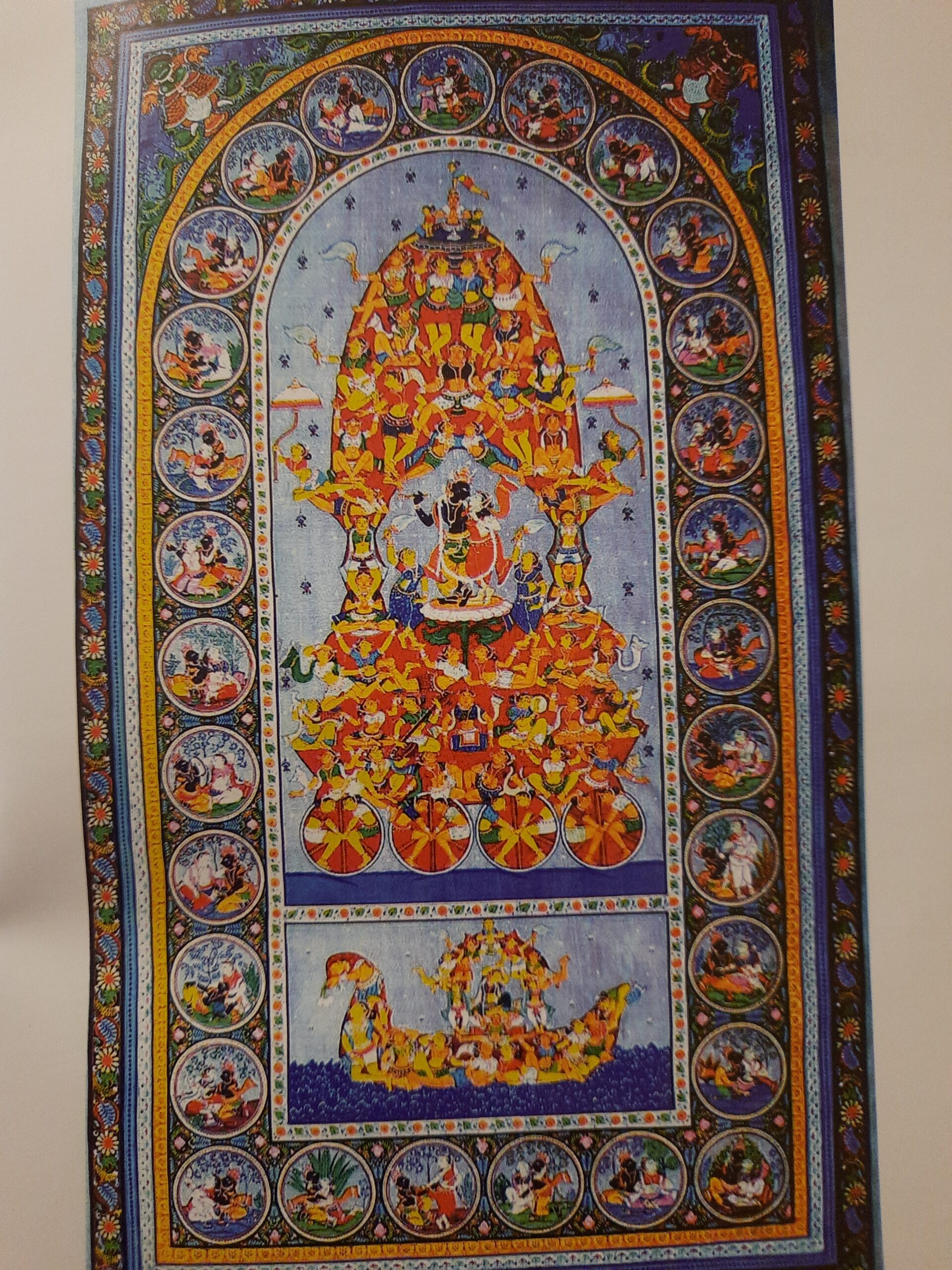 Kandarpa Ratham: Sri Krishna and Sri Radha in divine love at the center and the whole universe in the form of a ratham formed by the devoted gopis playing musical instruments and forming the parts of the divine ratham. Patta chitra painting from Odisha (Pic by Dr Susil Pani)
Kandarpa Ratham: Sri Krishna and Sri Radha in divine love at the center and the whole universe in the form of a ratham formed by the devoted gopis playing musical instruments and forming the parts of the divine ratham. Patta chitra painting from Odisha (Pic by Dr Susil Pani)
The ratha is often described as a devalaya and the deity is believed to be absent from the main shrine when the Utsavar is out. Dr Pani says, “The actual deity is absent from the main shrine truly only in one place, the Jagannath temple. Hence, only in Puri no puja is conducted inside when the Lord is taken out. (Symbolically) In all other places, a replica called utsava murti made from bronze is taken out in procession. In South India, only in Chidambaran Nataraja temple, the main deity is a bronze murthi which comes out for the rathyatra, another speciality is that Nataraja comes out twice a year.”
The introduction of the book traces the origins of the temples cars referring to a variety of rathas including devarathas, sangramik ratha, karni ratha etc. Information found in the agamas and shastras have been compiled and presented. The book also looks at the relationship between the temple and the ratha. The measurements, rituals and other details point to the brilliance of ancient Indian sculptors and architects.

